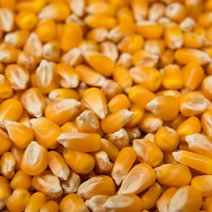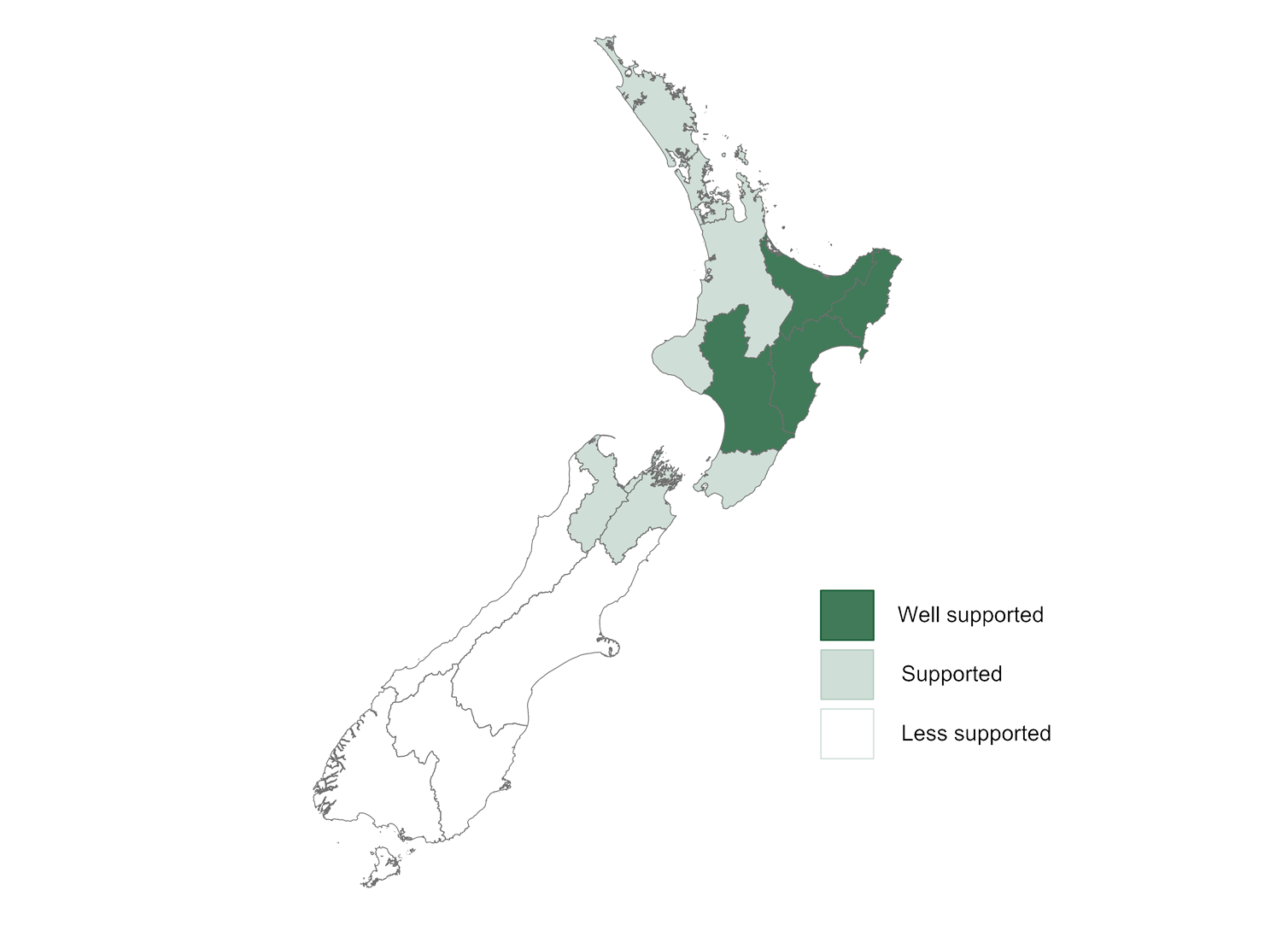
Land use fact sheet
Maize grain
Maize can be grown for silage or for grain. This fact sheet looks at maize grown for grain.
Maize is a versatile crop that can be grown in most parts of New Zealand other than the coldest parts of the South Island, but it is most prevalent and profitable on flat to rolling areas in the North Island. It may not provide the highest return per hectare, but it is relatively easy to grow and offers other options such as leasing to contract growers.
 Overview
Overview
Regions
Maize grain is grown throughout most of the regions of the North Island and the warmer regions of the South Island.
Growing conditions
Maize requires fertile land with good soil moisture. Land should be flat or gently rolling, so machinery can operate.
Climate
Different hybrids have been developed to suit a range of regional temperatures and water availability.
Commercial scale
Less than 5 hectares may be unprofitable. Bigger tends to be better, with larger blocks giving better profits.
Getting started
Most landowners lease to a maize grower. If you are the grower, you’ll need enough land to cover capital and other costs.
Skills / employment
Growing maize grain does not require a lot of experience, but it is important to seek advice from qualified sources.
 Regions
Regions
Maize competes with other horticulture, dairying and maize silage in most North Island regions and warmer South Island regions.
Get a report on your whenua
Enter the details of your whenua into our search to create a downloadable report showing information about the environment, economy, and climate in your region — and the potential that creates for development.

 Commercial scale
Commercial scale
To be commercially viable you need at least 5 hectares. Larger blocks have lower per hectare costs and other benefits of scale, so more land will provide better results.
Blocks under 5 hectares have higher costs per hectare, so they are less profitable.
 Getting into the industry
Getting into the industry
You can lease your land to another grower to use for maize, or grow your own crop to sell directly to a processor or local wholesaler. Make sure you have a contract for sale in place before your crop is planted.
Always take advice before signing a lease or contract, to make sure you are getting good value and that your land is being looked after properly.
Leasing
Established growers are often eager to discuss leasing land that they can use to extend their crop. The lease will include information about how long the lessee can use the land, what they are allowed to use it for, and how they have to maintain facilities and look after the land.
Growing on your land
A contract is an agreement with a processor or wholesaler that they will purchase your crop for a specific price, as long as it meets conditions such as how much will be delivered, harvest date and the quality of the crop. The contract is signed before you plant your crop.
Companies all over New Zealand offer contracts, but it can be difficult to secure one if they already have enough supply from existing relationships.
 Skills and employment
Skills and employment
Growing maize grain does not require a lot of experience but it is important to get advice. Seed merchant websites are a great place to get basic information and help from their reps.
The people who are carrying out the work on the crop need to be properly trained and experienced, or have proper supervision, when carrying out typical growing season activities like:
- spraying weeds
- soil testing and adding fertiliser and lime
- preparing the seed bed and planting
- crop monitoring and controlling weeds, pests and diseases
- knowing when and how to apply side dressing fertiliser, if needed
- harvesting and handling the harvested grain
- field management after the harvest, including when and how to replace nutrients and organic matter in the soil, winter cover crops and when to give the soil a break by reverting to a pasture system.
Understanding whenua management
Crop timetable
The land is prepped in autumn by spraying out perennial weeds and applying fertiliser and lime. Soil testing in winter will identify if any additional nutrients will be needed before planting and during growth.
Once the risk of frosts has passed in spring, the seed bed is prepared and planted. You may also need to do more weed spraying and fertilising.
For the first 6-10 weeks the crop is carefully monitored for insect and bird damage, or more weeds.
Harvesting takes place between March and June, when the grain is between 22% and 24% moisture. The actual data depends on when the crop was planted, which hybrid was planted and the growing conditions.
After the crop has been harvested nutrients and organic matter is replaced in the soil and a winter cover crop is planted.
 Compliance
Compliance
Levies
The Foundation for Arable Research Incorporated (FAR) collects an Arable Commodity Levy of $1 for every 10,000 seeds purchased. The levy is added to the price when you buy seed, so there is no need to complete a levy return.
Council regulations
Many councils require consents for access to irrigation water and for other activities related to changing land use.
Speak to your local council before investing in any detailed planning or development work to ensure you are aware of any consents or permits needed to start growing carrots on your whenua.
Meeting council compliance obligations
National policy statement for freshwater management (NPSFM)
The National Policy Statement for Freshwater 2020 gives local authorities direction on how they should manage freshwater under the Resource Management Act 1991. As such, some local authorities require growers and farmers to create a Farm Environment Plan (FEP). Make sure you're familiar with the FEP expectations in your region. Check with your local council about the requirements for your whenua or planned development.
Even if your region doesn't yet require an FEP, it's good practice to put one in place for your whenua as part of your business plan. The Foundation for Arable Research (FAR) provides templates you can use to create an FEP.
 Growing conditions
Growing conditions
The best yields come from LUC 1-4 land, high temperature and sunlight levels and soils with good nutrient levels, moisture retention and drainage.
Slope
Large farm machinery requires flat to rolling land, with no more than 15° slope.
Constraints
Maize is not suited to waterlogged soils or soil pH below 5.0 or above 6.5.
Do not grow maize within 77m of sweetcorn. Cross-contamination will damage the sweetcorn crop.
Crop rotation
All crops cause damage if planted in the same place for a number of years. One common rotation policy is to plant 3 years of maize followed by five years of a pasture system, such as grazing, before returning to maize.
 Climate
Climate
Frost
Maize is frost tender. Plant after the risk of frost has passed and harvest before autumn frosts begin.
Hybrids
Seek advice from your seed merchant to choose a hybrid to suit your region, local pests and your block's own microclimate and other characteristics.
 Water
Water
Maize is often grown without irrigation and many hybrids are drought tolerant, but the right amount of water will give you the highest yield.
Water is most important in the first five weeks from planting, three weeks before silking and three weeks after silking. Seek advice on the best regime for your crop.
 Market
Market
Most maize grain becomes stock feed, including poultry, pig, calf and dairy meal. Some is sold directly into the dairy industry or used for starch or human food, such as corn chips and breakfast cereal.
A small amount is exported, mostly to New Caledonia with some going to other Pacific Islands and Australia.
Import competition
New Zealand imports maize grain from up to 8 different countries each year. The price of imported grain impacts the price you can achieve as a grower.
 Future industry
Future industry
Reduced tillage techniques, precision farming and improved crop nutrient management are being used to reduce the impact of maize on soil health as well as reducing greenhouse gas production and loss of nutrients and sediment.
Better hybrid genetics are reducing the time to harvest as well as lifting the yield per hectare by around 180kg each year.
In warmer regions, a shorter time to harvest could allow the landowner to grow a different crop or pasture over winter.
 Operational costs
Operational costs
Pioneer provides a tool that lets you calculate detailed operational costs for your land block.
Pioneer maize for grain economics tool
Operational costs for an average yield of 11.1 tonne were around $3,375 per hectare in the 2019/2020 season.
 Grower returns
Grower returns
The Pioneer tool also allows you to estimate the return on your crop based on your actual expenses and yield.
Pioneer maize for grain economics tool
A high-level estimate is shown below.
Production
11.1 tonne per hectare
The AIMI maize survey shows that yield ranged from 10 tonne to 15 tonne of dry grain per hectare in 2018 and 2019. Dry grain has been dried to 14% moisture, after being harvested at 22-24% moisture.
The average yield was 10.9 tonne per hectare.
AIMI New Zealand survey of maize areas and volumes: June 1, 2019 [PDF 886KB]
Price to grower
$375 per tonne
The maize grain price varies between seasons and districts. In 2019 most maize crops were contracted at $375 - $380 per tonne.
Grower income
$800 per hectare
At an estimated $375 per tonne and 11.1 tonne per hectare, revenue per hectare is $4,163.
If costs are $3,375 per hectare the profit to the grower is just under $800 per hectare.
 Seek advice
Seek advice
Seek advice early, before you invest in any design or development.
Talk to your local Te Puni Kōkiri office to see how they can support you through your decision-making process. They will be able to provide advice and find out whether your project qualifies for funding.
The seed companies Pioneer and Corson Maize offer lots of resources on their websites, including hybrid selection tools, grower guides, expense/income calculators and contact details for their representatives.
Additional resources are available from the Foundation for Arable Research (FAR), which collects levies from maize and other arable crop growers in order to fund research and technology transfer programmes for the benefit of New Zealand growers.
If possible, seek out advice from people who grow maize in your area as well as knowledgeable suppliers.
Talk to qualified consultants who are experienced in maize growing and other land developments in your area. They will be able to provide detailed, impartial advice on what will (and won't) work on your whenua.
 About this fact sheet
About this fact sheet
This fact sheet provides general information to help start and inform conversations. It is not comprehensive enough to support detailed decision-making.
The information in this fact sheet has been contributed by AgFirst, StatsNZ, the Foundation for Arable Research (FAR), Corson Maize, Pioneer Maize, and Te Puni Kōkiri kaimahi. Data that has not been credited in the body of the fact sheet has been provided by the contributors or sourced from one of the following publications:
AIMI New Zealand Survey of Maize Areas and Volumes 2019 [PDF 886KB]
NZFMA Annual Feed Production Statistics for the Year Ending December 2018 [PDF 46KB]
Arable Production 2018: Economic impact assessment [PDF 2.9MB]
You can provide feedback on the content on this or any fact sheet by emailing the Whenua Māori Service at whenuainfo@tpk.govt.nz